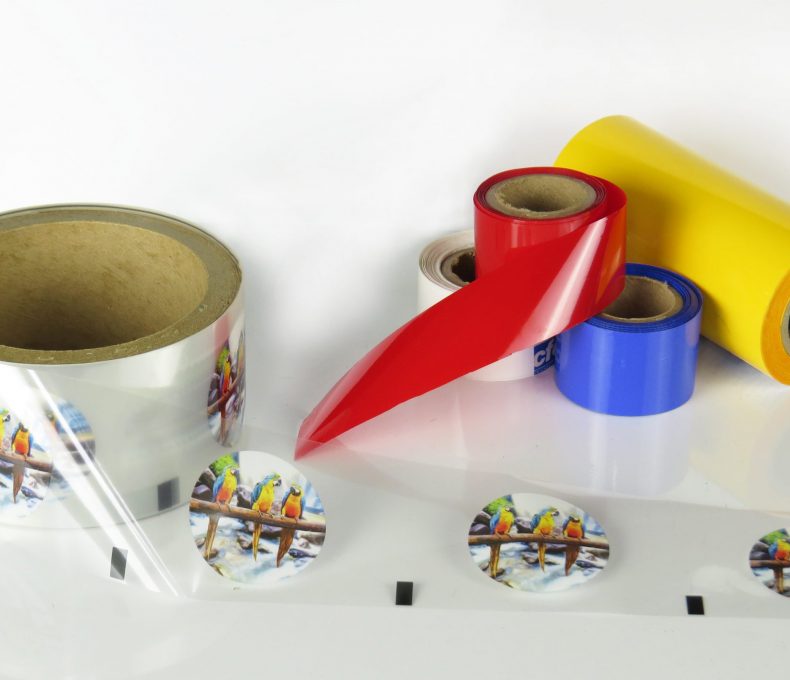Technology Comparison
Hot Stamp or Heat Transfer
The processes behind hot stamp and heat transfer decoration are very similar. Below please see a snapshot of some of the most important differences between the two techniques. Further down you will find a comprehensive list of benefits and considerations for each process.
The largest visual distinction between hot stamp and heat transfer decoration is in the number of colors used.
Multi-Color Decoration – Heat Transfer
Hot stamp typically involves using a single color foil whereas heat transfer decoration uses film pre-printed with multi-color images (heat transfer labels).
Premium Metallic Decoration – Hot Stamp
Hot stamp is superior at delivering quality decoration in metallic colors.

While hot stamp and heat transfer decoration processes are very similar, a difference can be seen in the dies used. The molds for hot stamp dies carry the image to be used. They are more complex than the molds used for heat transfer decoration where no graphic image is carried on the die (the image comes from heat transfer label itself).

Hot Stamp
Benefits and Considerations
| Hot Stamp Benefits | |
| Benefit | Description |
| Pigment, metallic, matte, and glossy colors | Foil is better than ink processes at delivering shiny or mirror effect finishes.
|
| Dry process | Unlike pad printing, hot stamping doesn’t use any wet ink or solvents. It is a dry decoration process using foil. There are no storage problems with flammable materials, strong odors, ink mixing, or messy clean-up; the decorated part is ready to be handled or packaged after stamping. |
| Instantaneous curing | No post-curing allows immediate handling and packaging |
| Minimal setup time | Artwork changeover on the same part requires a simple Die and/or Foil Roll change if transitioning from one color to the next. No clean-up of inks and tools required. Various tools available (including United Silicone’s magnetic die mounting system) to achieve ‘quick change’ transitions. |
| On-demand decorating | Unlike In-Mold Labeling (IML) that requires decoration at the same time parts are formed, hot stamp decoration can be accomplished either inline with molding machines or offline utilizing parts from inventory. This provides greater flexibility for users. It is not necessary to have complete artwork at the time the part is made. |
| Semi-skilled operators | When working with a dry process the equipment controls the process. Of course there are variables, but not as many as with other processes. |
| Opacity | Foils have superior opacity in one hit/application.. Pigment foils provide solid colors in flat or gloss finish, equivalent to a thick layer of opaque ink. |
| Object shape considerations | Flat or round objects are best suited for hot stamp or heat transfer, whereas objects with compound curves are not well-suited. |
| Object surface considerations | Objects with smooth surfaces are best suited for hot stamp or heat transfer, whereas objects with textured surfaces are not.
|
| Changing artwork requires changing dies | Graphic images are achieved with Silicone or Metal Dies. A new Die is required with each change in artwork. United Silicone can schedule Die lead times to meet production requirements. |
| Speed of application | Dwell time requirements vary from instant contact to up to 3 to 4 seconds in order to have a complete transfer of a large image to the part. |
Heat Transfer Decoration
Benefits and Considerations
| Heat Transfer Decoration Benefits | |
| Benefit | Description |
| Brilliant, multicolor graphics |
|
| Sustainable Technology (benefits dependent on particular heat transfer type selected) |
|
| Minimal setup time |
|
| On-demand decorating |
|
| Custom colors and formulations |
|
| Semi-skilled operators |
|
| Dry process |
|
| Instantaneous curing |
|
| Opacity |
Because Heat Transfer Labels are manufactured in layers (multiple ink passes/layers), image opacity is achieved in a single pass. This is in contrast to processes like Pad Printing where multiple hits may be required due to the thin lay down of ink. |
| Object shape considerations | Flat or round objects are best suited for heat transfer, whereas objects with compound curves are not well-suited for heat transfer. |
| Object surface considerations | Objects with smooth surfaces are best suited for heat transfer, whereas objects with textured surfaces are not. |
| Changing artwork may require changing Dies | Graphic images are achieved utilizing pre-printed Heat Transfer Labels. A new Die may be required with an artwork change dependent upon graphic shape, die design, and heat or witness mark tolerance. |
| Quantities required per image | Minimum Order Quantity (MOQ) may be required. The digital process provides variable print from label-to-label with no MOQ or set-up fee. |
| Heat transfer labels provided by a vendor | Leadtimes and MOQs for Heat Transfer Labels vary dependent upon manufacturing type – Digital, Screen Printed, Gravure, Polyfuze, Flexo, etc |
| Speed of application | Dwell time requirements vary from instant contact to up to 3 to 4 seconds in order to have a complete transfer of a large image to the part. |
| Pre-Treatment & Post-Treatment may be required (Wax Transfers Only) | Whereas the elimination of pre- and post- treatments is a considerable advantage of hot stamp and heat transfer, wax transfers are the exception to this rule and may require treatment. Post-treat: used to “gloss-up” label graphics; delivers outstanding image quality |